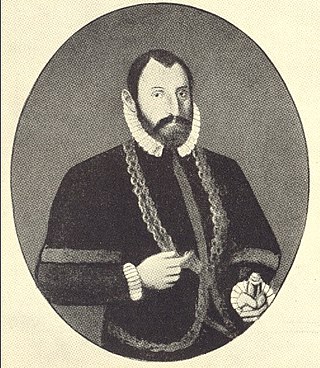Siegen-Wittgenstein is a Kreis (district) in the southeast of North Rhine-Westphalia, Germany. Neighboring districts are Olpe, Hochsauerlandkreis, Waldeck-Frankenberg, Marburg-Biedenkopf, Lahn-Dill, Westerwaldkreis, and Altenkirchen.
Altenkirchen is a district in Rhineland-Palatinate, Germany. It is bounded by the North Rhine-Westphalian districts Rhein-Sieg, Oberbergischer Kreis, Olpe and Siegen-Wittgenstein, and the districts of Westerwaldkreis and Neuwied.

Sayn-Wittgenstein was a county of medieval Germany, located in the Sauerland of eastern North Rhine-Westphalia.

Sayn-Wittgenstein-Berleburg-Ludwigsburg, also known as Sayn-Wittgenstein-Ludwigsburg, was a cadet branch of the Sayn-Wittgenstein-Berleburg family.
Sayn-Homburg was a mediaeval county of Germany with its seat at Homburg Castle. It was created as a partition of Sponheim-Sayn in 1283. In 1345, Salentin, the son of Count Godfrey, married the heiress of Wittgenstein and the Counties were united and, on his death, merged to form the County of Sayn-Wittgenstein.
Sayn-Wittgenstein-Vallendar was a County of the Holy Roman Empire in Germany. It was created as a partition of Sayn-Wittgenstein-Wittgenstein, and was inherited by Sayn-Wittgenstein-Hohenstein in 1775.

Sayn was a small German county of the Holy Roman Empire which, during the Middle Ages, existed within what is today Rheinland-Pfalz.

Sayn-Wittgenstein-Sayn was a county of Rhineland-Palatinate, Germany, comprising the lands of the region of Sayn. It was created as a partition of Sayn-Wittgenstein in 1607, although it was not until the next year that it obtained fully the Countship of Sayn. The succession was never clear, leading to the annexation of the county in 1623 by the Archbishop of Cologne. It was not until a treaty in 1648 that it was decided the county would pass to the sisters Ernestine and Johanette of Sayn-Wittgenstein-Sayn, under the regency of their mother, Countess Louise Juliane von Erbach (1603–1670). They partitioned the county into Sayn-Wittgenstein-Sayn-Altenkirchen and Sayn-Wittgenstein-Hachenburg soon after.
Ludwig Wittgenstein was an Austrian-British philosopher.

Bad Berleburg is a town, in the district of Siegen-Wittgenstein, in North Rhine-Westphalia, Germany. It is one of Germany's largest towns by land area. It is located approximately 30 km (19 mi) northeast of Siegen and 35 km (22 mi) northwest of Marburg an der Lahn.

Munich International School (MIS) is a private coeducational international school located in Starnberg, south of Munich, Germany. MIS teaches students from EC to grade 12. Students travel from an area around Munich to attend the school, with the help of a school bus network that reaches into the area around Munich, even all the way to Garmisch-Partenkirchen. The School is divided into three groups: Junior, Middle, and Senior School.
Mannus Riedesel (1662–1726) was a master builder in the early 18th century in the Counties of Wittgenstein and surrounding areas, now part of the district of Siegen-Wittgenstein in the state of North Rhine-Westphalia in the Federal Republic of Germany. At least ten structures that he built are known to exist, and are regarded as jewels of "half-timbered" Fachwerk construction."

Sayn-Wittgenstein-Hohenstein was a county and later principality between Hesse-Darmstadt and Westphalia.

Sayn-Wittgenstein-Berleburg was one of several imperial counties and later principalities ruled by the House of Sayn-Wittgenstein.

Prince Frederick William II of Nassau-Siegen, German: Friedrich Wilhelm II. Fürst von Nassau-Siegen, official titles: Fürst zu Nassau, Graf zu Katzenelnbogen, Vianden, Diez, Limburg und Bronkhorst, Herr zu Beilstein, Stirum, Wisch, Borculo, Lichtenvoorde und Wildenborch, Erbbannerherr des Herzogtums Geldern und der Grafschaft Zutphen, was since 1722 Fürst of Nassau-Siegen, a part of the County of Nassau. He descended from the House of Nassau-Siegen, a cadet branch of the Ottonian Line of the House of Nassau. He was the last male representative of his lineage, with him the Protestant line of the House of Nassau-Siegen became extinct.
Countess Louise Juliane of Erbach was a German regent; Countess of Sayn-Wittgenstein-Sayn by marriage to Ernest of Sayn-Wittgenstein-Sayn, she acted temporarily as regent of Sayn-Wittgenstein-Sayn. She is remembered as the title character of the novel Die Gräfin von Sayn by Karl Ramseger-Mühle.

Louis I, Count of Sayn-Wittgenstein, nicknamed "the Elder", formally "Louis I of Sayn, Count at Wittgenstein" ruled the County of Wittgenstein, on the upper reaches of the rivers Lahn and Eder, from 1558 until his death. He converted his county to Calvinism and was an influential politician in the service to the Electoral Palatinate.

Johanetta of Sayn-Wittgenstein was German countesses of the house of Sayn-Wittgenstein, who became the third wife of Count John VI, Count of Nassau-Dillenburg.

Duchess Amalie Louise of Courland, German: Amalia Luise Herzogin von Kurland, official titles: Herzogin in Livland, zu Kurland und Semgallen, Fürstin zu Pilten, was a duchess from the House of Kettler and through marriage Fürstin of Nassau-Siegen. She was regent of the Principality of Nassau-Siegen for her stepson Frederick William II in the period 1722–1727.

Countess Sophie Polyxena Concordia of Sayn-Wittgenstein-Hohenstein, German: Sophia Polyxena Concordia Gräfin zu Sayn-Wittgenstein-Hohenstein, official titles: Gräfin zu Sayn, Wittgenstein und Hohenstein, Frau zu Homburg, Vallendar, Neumagen, Lohra und Klettenberg, was a countess from the House of Sayn-Wittgenstein-Hohenstein and through marriage Fürstin of Nassau-Siegen.













